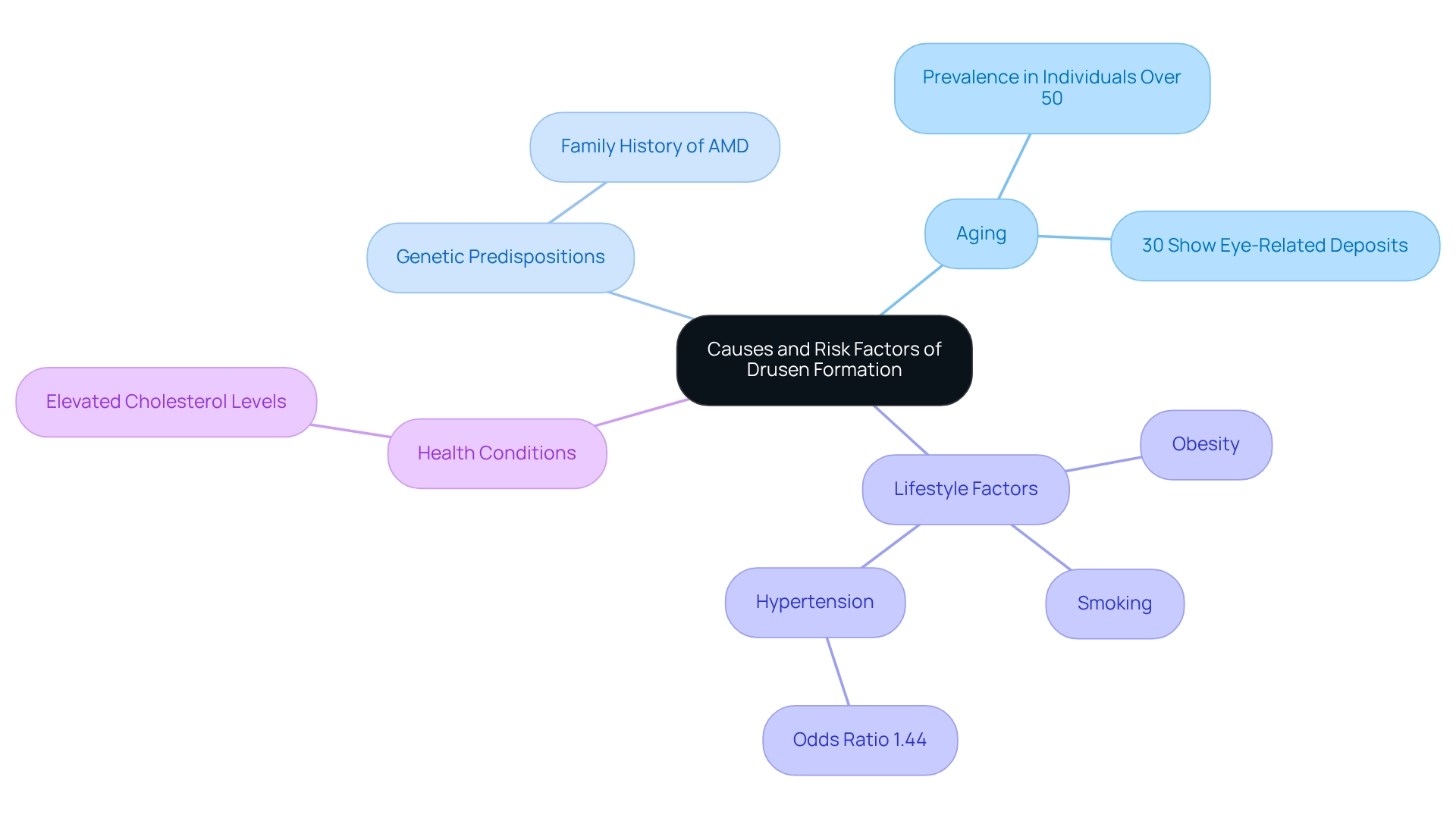Posted by: Northwest Eye in General on June 11, 2025
Overview
Drusen are small yellow or white deposits beneath the retina that can indicate the early stages of age-related macular degeneration (AMD), a leading cause of vision loss in older adults. We understand that learning about these deposits may raise concerns about your eye health. Their presence signals potential risks for AMD, which is why it’s so important to prioritize regular eye examinations.
By monitoring these deposits effectively, you can take proactive steps to manage your eye health. It’s common to feel uncertain about what this means for you, but rest assured that lifestyle modifications can make a significant difference. We are here to help you through this process and encourage you to seek the support you need.
Introduction
In the realm of eye health, we understand that concerns about vision can be daunting. Drusen, those small yellow or white deposits that accumulate beneath the retina, serve as critical indicators that may signal the onset of age-related macular degeneration (AMD), a leading cause of vision loss among older adults. Often overlooked, these deposits hold significant implications for eye health, and it’s common to feel uncertain about what they mean for you.
As our population ages, it becomes increasingly essential to understand the formation, symptoms, and management of drusen. This article aims to explore the multifaceted nature of drusen, delving into their causes, risk factors, diagnostic techniques, and current management strategies. Our goal is to provide you with the information you need to preserve your vision and enhance your quality of life.
We are here to help you through this process, offering support and guidance as you navigate your eye health journey.
Define Drusen and Its Significance in Eye Health
Small yellow or white deposits known as drusen accumulate beneath the retina and are primarily composed of lipids, proteins, and cellular debris. These deposits can vary in size and are commonly associated with the aging process. The presence of drusen is particularly significant, as they often indicate the early stages of (AMD), a leading cause of vision loss among older adults. We understand that this can be concerning, and it’s important to know that you’re not alone in this journey.
Comprehending drusen deposits is essential for both patients and healthcare providers, as they act as important indicators for tracking eye health and possible disease advancement. Research suggests that the occurrence of drusen rises with age, making them a frequent observation in older adults. In fact, studies indicate that a significant proportion of individuals over 60 display drusen, emphasizing their relevance in the context of AMD. For instance, in a participant pool of 95 women, the presence of eye deposits was notably observed, underscoring their relevance in this demographic.
Drusen can affect eye health by indicating the risk of developing more severe forms of AMD, potentially resulting in significant vision impairment. A review of existing literature has underscored the role of zinc in the retina, suggesting that it may help mitigate oxidative stress associated with AMD. This protective effect is particularly relevant given the structural role of zinc in antioxidant enzymes, which are crucial for maintaining retinal health. The BrightFocus Foundation emphasizes that understanding drusen is essential for effective management of AMD, although they do not endorse any specific medical products or therapies.
Expert opinions highlight the significance of observing drusen as part of a comprehensive eye health strategy. Ophthalmologists observe that regular eye examinations can assist in identifying drusen early, which enables prompt intervention and management of AMD. Moreover, ongoing research persists in investigating the connection between these deposits, known as drusen, and AMD, with findings suggesting that comprehending them can result in improved prevention and treatment strategies. Notably, the analysis suggests that further research is unlikely to change the results of the review, indicating a need for current strategies to be effectively implemented.
In summary, these deposits known as drusen are not merely incidental findings; they are significant indicators of eye health that warrant careful monitoring, especially in older adults. Their presence can guide healthcare providers in assessing the risk of AMD related to drusen and implementing appropriate management plans to preserve vision. Remember, we are here to help you through this process, and understanding these aspects of is a crucial step towards maintaining your vision.
Explore Causes and Risk Factors of Drusen Formation
The formation of drusen is predominantly associated with aging, showing significant prevalence in individuals over 50 years old. We understand that this can be concerning, as research indicates that nearly 30% of this demographic may show some degree of eye-related deposits. Key risk factors contributing to the formation of drusen include:
- A family history of (AMD)
- Smoking
- Obesity
- Hypertension
- Elevated cholesterol levels
It’s important to note that individuals with hypertension have an odds ratio of 1.44 for developing retinal deposits, emphasizing the necessity of managing blood pressure for your eye health.
Genetic predispositions also play a crucial role in the likelihood of deposit formation. Understanding these risk factors is essential for you to adopt preventive measures, such as lifestyle modifications and regular eye examinations. Regular eye examinations are vital for monitoring the progression of drusen, which can aid in preventing possible vision loss.
Recent findings suggest that classical deposits are significantly associated with a thicker choroid, while reticular pseudodeposits (RPD) correlate with a thinner choroid. This distinction signifies different underlying processes in the formation of yellowish drusen deposits and highlights the complexity of AMD. The proposed two-level hypothesis from recent research highlights the role of systemic inflammation and molecular damage in the pathophysiology of AMD, emphasizing the need for ongoing investigation in this area.
As Dr. Sara N. Frye indicates, “There is no remedy for macular degeneration, but there are therapies accessible that can delay the advancement of the condition and assist in maintaining sight.” By remaining knowledgeable about these risk factors and participating in proactive eye care, you can more effectively manage your eye health and reduce the effects of deposits and AMD.

Identify Symptoms and Diagnostic Techniques for Drusen
While drusen typically do not present significant symptoms on their own, we understand that they can lead to changes in vision associated with age-related macular degeneration (AMD). It’s common to feel concerned about this, as frequent indicators linked to deposits and AMD include:
- Blurred or distorted vision
- Difficulty adapting to different lighting conditions
- The appearance of blank spots in [central vision
[Blurred vision](https://nweyeclinic.com/9-key-retinal-detachment-symptoms-to-recognize-early)](https://nweyeclinic.com/?p=4652) can also be a symptom of other conditions, such as cataracts and diabetic retinopathy, which may add to your worries.
To accurately identify these drusen deposits, several diagnostic techniques are available. Comprehensive eye exams, retinal imaging, and optical coherence tomography (OCT) are employed to help ophthalmologists detect the presence of drusen and assess their size and distribution. This information is crucial in evaluating the likelihood of progression to advanced AMD.
We encourage regular evaluations, especially for patients with , as recommended by specialists in the field. Remember, you are not alone in this journey, and we are here to help you through the process. Your eye health is important, and seeking care is a positive step forward.
Review Treatment Options and Management Strategies for Drusen
Currently, we understand that there is no specific treatment for these yellowish deposits. However, effective management strategies focus on monitoring and addressing associated conditions, particularly age-related macular degeneration (AMD). We encourage patients to adopt a healthy lifestyle, which includes:
- A balanced diet rich in antioxidants
- Regular physical activity
- Avoiding smoking
Research indicates that lifestyle modifications can significantly impact the progression of AMD. Studies show that individuals who adhere to a Mediterranean diet may experience reduced risk factors associated with the disease. The Cochrane Heart Group’s review in 2013 supports this, concluding that the Mediterranean diet may reduce cardiovascular risk factors, which can be beneficial for eye health.
Nutritional supplements, such as those containing vitamins C and E, zinc, and lutein, may also be recommended to help slow AMD progression. For patients with advanced AMD, treatment options include:
- Laser therapy
- Intravitreal injections
These treatments aim to manage symptoms and preserve vision. A pilot study involving 27 participants with bilateral deposits highlighted the potential of laser treatment, with the number of laser spots ranging from one to 100. However, challenges in follow-up limited the assessment of its effectiveness, underscoring the necessity for careful monitoring in future studies.
Regular follow-ups with an ophthalmologist are crucial for tracking changes in and drusen. We emphasize the importance of personalized management strategies, which may include dietary adjustments and routine eye examinations to ensure timely intervention and optimal care. As noted by DG, ‘Although further studies are needed, our findings provide further evidence for the potential value of the Mediterranean diet pattern on eye health and may encourage the development and implementation of lifestyle-modifying strategies aimed at reducing the risk of AMD progression.
Conclusion
Drusen are critical indicators of eye health, especially concerning age-related macular degeneration (AMD), a leading cause of vision loss in older adults. We understand that learning about these small deposits can be concerning, but it’s essential for both patients and healthcare providers. Drusen not only signify potential risk for AMD but also guide effective monitoring and management strategies. As the prevalence of drusen increases with age, regular eye examinations become even more important. Detecting their presence early allows for timely interventions, helping to safeguard your vision.
Identifying the causes and risk factors associated with drusen formation is equally vital. Factors such as aging, genetic predisposition, and lifestyle choices—like smoking and obesity—play significant roles in their development. By staying informed about these risks and engaging in proactive eye care, you can better manage your eye health and potentially mitigate the impact of drusen and AMD.
While there is currently no specific treatment for drusen, effective management focuses on monitoring and addressing associated conditions. Emphasizing a healthy lifestyle, including a balanced diet rich in antioxidants and regular physical activity, can significantly influence the progression of AMD. Nutritional supplements may also play a role in preserving vision. We encourage you to have regular follow-ups with an ophthalmologist, as these appointments are crucial for tracking changes in drusen and ensuring optimal eye health.
Ultimately, awareness and understanding of drusen are paramount in preserving vision and enhancing your quality of life as you age. By prioritizing eye health through education, regular check-ups, and lifestyle modifications, you can take proactive steps towards safeguarding your vision and overall well-being. Remember, we are here to help you through this process.
Frequently Asked Questions
What are drusen?
Drusen are small yellow or white deposits that accumulate beneath the retina, primarily composed of lipids, proteins, and cellular debris.
Why are drusen significant in eye health?
The presence of drusen is significant as they often indicate the early stages of age-related macular degeneration (AMD), a leading cause of vision loss among older adults.
How do drusen relate to age?
The occurrence of drusen increases with age, making them a common observation in older adults. A significant proportion of individuals over 60 display drusen.
What is the impact of drusen on vision?
Drusen can indicate the risk of developing more severe forms of AMD, potentially leading to significant vision impairment.
What role does zinc play in eye health concerning drusen?
Zinc may help mitigate oxidative stress associated with AMD, playing a protective role in maintaining retinal health due to its involvement in antioxidant enzymes.
How can drusen be monitored?
Regular eye examinations can assist in identifying drusen early, enabling prompt intervention and management of AMD.
What is the importance of understanding drusen for healthcare providers?
Understanding drusen is essential for effective management of AMD, as they serve as important indicators for tracking eye health and potential disease advancement.
Is there ongoing research related to drusen and AMD?
Yes, ongoing research is investigating the connection between drusen and AMD, with findings suggesting that understanding these deposits could lead to improved prevention and treatment strategies.






